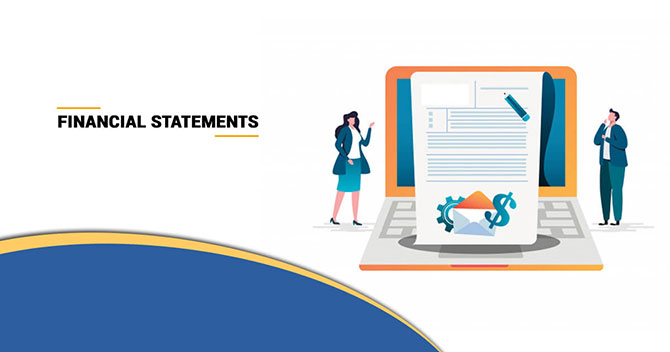Financial Statements are the reports that present the financial performance and financial position of a company for a particular period, usually a fiscal year. Financial statements consist of a set of records that has to be maintained by the company, sole proprietorship or businesses that include books of account, balance sheet, trial balance, trading account, Profit and loss account, cash flow statement, statement of owner’s equity, and income statement.
The financial statements are used by outsiders such as creditors, investors, customers, etc. to know more about the entity’s financial aspects. A public company has to present these statements to regulators as well on the prescribed interval of time.
A financial statement is the main source of information for decision-makers before investing in the company or when entering into a deal such as a merger & amalgamation.
Understanding Financial Statements
The financial statement records the financial activities and transactions that have occurred in an entity. These are written reports presenting the financial strength and liquidity position of a company. These reports reflect the effect of financial transactions on business as a whole.
Financial statements are prepared at the end of the fiscal year when all the books of accounts are maintained to date and duly audited. Financial statements are useful for stakeholders such as shareholders, creditors, investors, government, and other interested parties.
Preparation of financial statements depends upon the following elements such as:
- Recorded Information: For the preparation of financial statements, documented facts in books of accounts are considered to take into account the figures of fixed assets, liabilities, trade receivable & payables, etc.
- Assumptions: Assumption plays a vital role in the formulation of financial statements. Few assumptions are taken as self-evident principles.
- Personal Opinion: Financial Statements shall be prepared based on accounting statements; however, there is a scope of own judgment also while making statements, and these play a significant role during preparation.
- Conventions of Accounting: Accounting Standards[1] prescribe the applicable convention in accounting. These conventions are required to be adhered to while formulating financial statements.
Objectives of Financial Statements
There are two types of objectives that an entity strives to achieve via its financial statements:
- Primary objectives
- Secondary objectives
Following are the primary objectives of Financial statement:
- With the help of financial statements, there is a clear understanding of the profit earning potential of an entity. Also, it focuses on whether profits have increased or decreased as compared to the preceding year.
- Financial statements help in estimating whether the business can repay its debt in the short term or long term, i.e., solvency.
- Financial reports let an entrepreneur compare the performance of the company over the past year that leads to the conclusion about the growth of the company.
- The company can access the potential strengths and weaknesses of an organization. By knowing the areas where the company lacks behind, it can take corrective actions to remove the obstacles.
- It helps in communicating the financial position of the company to the concerned parties. Apart from promoters and employees, there are several stakeholders, including shareholders, debenture holders, creditors, investors, government, etc., who are connected with the entity and are interested to know about its potential.
Specific secondary objectives of financial statements are:
- By providing the periodical statement of earnings, one can evaluate the earning capacity of the firm.
- The financial statement helps in decision making related to the merger, amalgamation, and takeover.
- The company can estimate its capacity to enter diversification or expansion plans.
- The government gets the necessary information about the company that helps in proper fixation of taxation, duties, and price control.
- Any deviation between the projected budget and actual performance can be evaluated to take corrective
- Internal management forms internal policies based on financial statements.
- Through financial reports, shareholders build their confidence and are assured about the safety of their investments.
- Credit rating companies analyze the financial position of the company through these statements for proper credit ratings.
Users of Financial Statements
Financial Statements are considered as a useful tool to serve the common purposes of the users of accounting information. Financial reports are used to analyze the financial position of the company for various reasons. Following are the internal & external users of financial reports:
Internal Users
- Employees
- Management
External Users
- Trade creditors
- Investors
- Government
- Customer
- Lenders
- Society and public at large
Kinds of Financial Statements
Following are the types of financial statements:
1. Balance Sheet:
It is one of the components of a financial statement that represent the financial position of the business. It is also known as the statement of financial position or financial condition. Balance Sheet has two columns, i.e., Assets & liability side. Details of the assets and capital contributions are shown on the asset side, while its debt and liabilities represent the liability side. In a nutshell, the Balance Sheet shows the funds available to the company and its utilization.
A Balance Sheet consists of three elements:
- Assets: Resources controlled by the business are known as assets. They can be tangible or intangible assets or can be classified as current & non-current assets. Current assets are those that can be converted into cash within a year
- Liability: Liability is the amount of debt owed by the company to lenders and creditors. Liabilities are classified into current liabilities, which are payable within a year such as a bill payable, creditors, etc. and non-current liabilities, which are not payable within a year such as a loan, debentures, etc.
- Owner’s equity: It includes the amount of capital contribution by an owner. It is the classification of shares paid-up, subscribed, unpaid, or outstanding.
2. Income Statement:
Income Statement reveals the financial performance of the company in terms of net profit or loss that occurred at the end of the financial year, also known as Profit & Loss account. P&L Account gives the financial performance of the business over a time period and consists of two elements, i.e., Revenue (all cash inflows in the company) and Expense (all cash outflow from the company)
- Cash Flow Statement:
Cash flow statement represents the movement in cash and bank balances. Following are the segments in which cash flow moves:
- Operating Activities
- Investing Activities
- Financial Activities
- Statement of Change in Equity:
This statement gives the details of the movement in the owner’s equity. This is also called statement of retained earnings at the end of the period i.e. it is a profit at the end of the period to pay off the liabilities. The statement of retained earnings may as well be known as owner’s equity statement, shareholders equity statement or an equity statement.
Retained Earnings = Beginning of Retained Earnings + Net Income –Paid Dividends
Following components are used to derive the movement in owner’s equity:
- Net profit or loss during the year as per Income Statement
- Share capital raised or repaid during the period
- Dividend payment
- Changes in accounting policy and its effects.
Conclusion
Financial statements include the income statements and positional statements that ensure to represent the actual financial position of the business to management and external stakeholders. This opens the window for decision making and strategic planning, as well. Proper understanding of these statements goes a long way in the promotion of the financial health of the organization. For any assistance for the preparation of financial reports, contact us.
Read our article:What are Mergers and Acquisitions? A Detailed Outlook











